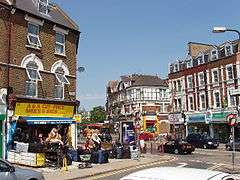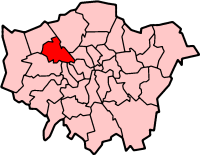Harlesden
Harlesden /ˈhɑːrlzdən/ is an area in the London Borough of Brent, North West London. Its main focal point is the Jubilee Clock which commemorates Queen Victoria's Golden Jubilee.[2] Harlesden has been praised for its vibrant Caribbean culture and unofficially named London's reggae capital.[3] The population includes people of Afro-Caribbean heritage most notably, as well as Irish, Portuguese, Brazilian, Somalis and smaller Latin Americans and East Africa groups within the community.
| Harlesden | |
|---|---|
 Craven Park Road | |
 Harlesden Location within Greater London | |
| Population | 17,162 (Harlesden ward 2011)[1] |
| OS grid reference | TQ215835 |
| London borough | |
| Ceremonial county | Greater London |
| Region | |
| Country | England |
| Sovereign state | United Kingdom |
| Post town | LONDON |
| Postcode district | NW10 |
| Dialling code | 020 |
| Police | Metropolitan |
| Fire | London |
| Ambulance | London |
| UK Parliament | |
| London Assembly | |
History
In the 19th century, Harlesden, then a rural village, began to develop some of its urban appearance with the arrival of the railways. Willesden Junction, Kensal Green and Harlesden stations all had an effect on the developing village. Cottages for railway and industrial workers were built, as was grander housing for the local middle class.
Harlesden increasingly lost its rural nature, with factories replacing farms and woodland. From late Victorian times until the 1930s, housing completed its spread across the area, and Harlesden became part of the London conurbation. Mainly after World War I, one of Europe's biggest industrial estates was constructed at nearby Park Royal, and large factories there included McVitie & Price (later United Biscuits) from 1910, and Heinz from 1919.
At 6am, January 16 1939, the Irish Republican Army blew up the Harlesden electricity cable bridge. The bridge crossed the Grand Junction Canal, and carried the power line from Battersea Power Station. No one was injured in the attack.[4]
The wedding cake for the Queen and Prince Philip, who were married in 1947, was baked at McVitie's Factory in Harlesden.[5]

The image of Harlesden today began to take shape in the 1950s, 1960s and 1970s. Continued immigration from Ireland and new immigration from the Caribbean, the Indian sub-continent and Africa changed the racial and cultural make up of the area.[6] More recently the area has become home to Brazilian and Portuguese communities. In 2011, 71.4% of homes were apartments across the ward, 15.8% of homes were terraced houses, 8.6% semi-detached houses and 4% detached houses; with 0.1% of the homes mobile or temporary structures.[7] Most of the terraces are pre-1920s and the flats converted from them. Many of the flats date to after 2000. Non-mixed use terraces and private sector built apartments are the main housing types that attract high prices from private sector owner-occupiers unable to afford similar properties in nearby Kensal Green and Queen's Park.
Starting in 1999, Harlesden and the nearby Stonebridge estate, witnessed a high number of murders and became a crime hotspot, because of several rival yardie gangs. During this time Harlesden turned into one of London's main crack cocaine trading centres, and one of the yardies' strongholds.[8][9][10] By 2001 the area had the highest murder rate in Britain.[11] There were 26 shooting incidents that year alone.[12] Crime rates were significantly reduced in the late 2000s.
During the nationwide riots of 2011, some shops in Harlesden were attacked by looters.[13]
Demography
The 2011 census results for Harlesden ward counted a population of 17,162. Harlesden is ethnically diverse. 67% of the population identified themselves as being BAME (Black, Asian and minority Ethnic) at the 2011 census in the Harlesden ward.[14] Ethnically, 19% of the population was Black Caribbean, followed by 19% Black African (both including those of mixed heritage), 15% Other White, and 14% White British.
The main spoken foreign languages were Portuguese and Somali.[15]
Transport and locale
Tube/rail
Stations in the area are:
- Willesden Junction Station (Bakerloo line, Watford DC Line, North London Line and West London Line)
- Harlesden Station (Bakerloo line and Watford DC Line)
Notable residents
References
- Census Information Scheme (2012). "2011 Census Ward Population Estimates". Greater London Authority. Retrieved 30 January 2013.
- "Archived copy". Archived from the original on 29 January 2009. Retrieved 28 January 2009.CS1 maint: archived copy as title (link)
- "Harlesden boasts highest number of minority-owned businesses". www.voice-online.co.uk. Retrieved 12 June 2019.
- "Harlesden Explosion". Coventry Evening Telegraph. 16 January 1939.
- "Hours to bake". Daily Mirror. 15 November 1947.
- "Harlesden (Ward) Ethnic Group (UV09)". 2001 Census Neighbourhood Statistics. Office for National Statistics. 2001. Retrieved 6 March 2008.
- "KS401EW - Dwellings, household spaces and accommodation type", 2011 Census, UK Government www.nomisweb.com
- Staff, Guardian (18 July 1999). "Yardie terror grips London". The Guardian.
- "Murders rising in 'Yardie' drug war". 6 July 1999.
- "BBC News | UK | Police tackle London's Yardies".
- "Time to take guns out of community". news.bbc.co.uk. 15 February 2001. Retrieved 23 April 2016.
- "Archived copy". Archived from the original on 3 March 2016. Retrieved 29 November 2016.CS1 maint: archived copy as title (link)
- "Harlesden traders attacked as looters attempt to storm their shops".
- https://data.london.gov.uk/dataset/ward-profiles-and-atlas
- "Harlesden - UK Census Data 2011".
- "Enders' Phil: I Just Flipped". The Daily Mirror. London. 12 August 2007.
- "Shane Richie: You Ask The Questions". The Independent. London. 18 December 2003.
External links
- Harlesden Town Centre Partnership at the Wayback Machine (archive index)
